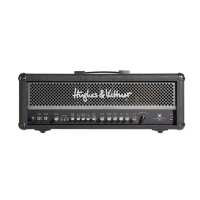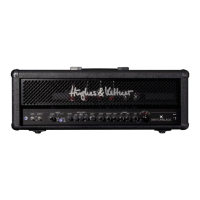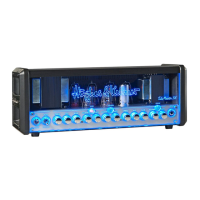7
english
- a tube is receiving insufficient power and the amp is running on one less than a
full set of tubes (see section 5.2.3)
- an overload has damaged a tube and TSC has switched off the affected tube pair
(see section 5.2.4)
- tubes are (still) matched (see 5.3)
Heads up: LEDs are arrayed side by side in the same order as the power amp
tubes, with each LED indicating the status of the tube occupying the same
position.
5.2.1 All LEDs off:
Power output tubes are operating normally.
5.2.2 All LEDs light up and stay on:
When you switch on the amp: All LEDs remain on for as long as the amp is in
standby mode to indicate tubes are heating up but no current is flowing to them.
If you wait long enough – about 30 seconds – and switch from standby to on,
the LEDs must extinguish. If you don’t allow the tubes enough time to heat up
before you begin playing, the LEDs will continue to light up until the tubes have
reached the proper operating temperature and the optimum current flow has been
achieved.
While playing: All LEDs light up the current flow to tubes is interrupted. The
most likely cause is a defective anode fuse. Change it. If the problem recurs any
time soon, or replacing the anode fuse doesn’t do the trick, take the amp to an
authorized service technician for a checkup.
5.2.3 One LED lights up continuously:
The tube assigned to this LED is producing under-voltage.
Causes can include a malfunctioning tube heater, a vacuum
fault, or other defect such as a broken filament within the
tube.
TSC adjusts the current for as long as possible. The tube will definitely work
longer than in a conventional amp and the defective tube will not cause the amp
to immediately generate undesirable crossover distortion. TSC ensures the best
possible sound under these conditions. Even if this is a major defect and TSC can
no longer adjust the current, you can continue playing the amp. If the LED fails
to extinguish after a few minutes, replace the power output tube. But before you
do, be sure to read section 5.3.2 and chapter 8. If the problem recurs soon, have
an authorized service technician check the amp.
5.2.4 One LED flashes, another lights up continuously:
The tube assigned to this flashing LED is generating
over-voltage. It’s defective, has been disabled, and must be
replaced. Before you do so, read and heed section 5.3.2 and chapter 8. In this
kind of power amp, it takes a pair of tubes working together to produce the best
sound. TSC switches off the defective tube’s partner so it doesn’t degrade the other
pair’s tone. This tube’s LED lights up to indicate it is also switched off, but there’s
no need to replace it. Switchblade 100 TSC sports four power output tubes, so
you can continue playing, though output is halved from 100 to 50 watts for as
long as the LED remains illuminated. Switchblade 50 TSC comes with two power
output tubes, so it will of course be muted. If this occurs in a conventional amp,
its fuse usually trips and you can’t operate it until you replace the tube and fuse.
Exception: In very rare cases, the anode fuse may trip for safety reasons despite
TSC’s best efforts. This may take place in response to serious tube defects such
as a short-circuit caused by the anode and cathode making direct contact, or the
voltage spikes when using older tubes and fuses. If you experience one of these
rare events, have a technician replace the tubes and fuses (see the chapter 8 und
5.3.2).
5.3 Matching tubes with TSC:
Experience has taught us that even minor outside influences
can have a major impact on a power output tube’s
characteristics. In conventional amps, they can change a
tube’s bias point so it no longer matches its partner and the
other output tubes. Tubes running at other than the proper
load cause undesirable noise such as crossover distortion,
which adversely affects the amp’s tone. They also wear faster
and must be replaced sooner.
TSC can help in three ways:
1. TSC minimizes undesirable crossover distortion and achieves the best possible
sound.
2. TSC cuts down on tube wear by adjusting bias, automatically and continually.
3. TSC lets you check and match the current status of every old or new tube’s
characteristics (see chapter 5.3.1).
5.3.1 Checking power output tube matching
Insert a pick into the slot in the panel labeled Tube Matching Read-Out while the
amp is on (as opposed to in standby mode). Then all of the Tube Status Control’s
LEDs will flash and indicate Hughes & Kettner ratings as shown in the tables in
section 5.3.3. You can buy tubes with the same ratings from your local dealer. The
original Hughes & Kettner rating (S1-S3) is labeled on the tube. Ideally, all tubes
will share the same ratings or diverge by no more than five flashes. If the rating
deviates upward or downward by six or more flashes, replace the given power
output tube. Again, be sure to first read and heed section 5.3.2 and chapter 8.
Unlike conventional biasing solutions, there’s no risk that tubes will wear faster
because TSC automatically adjusts the idle current to prolong tube life. However,
matched tubes will yield the best tone.
5.3.2 Checking for matching ratings when swapping tubes
If you replace all tubes, make sure they all have the same ratings. The choice of
rating is up to you. Different ratings won’t cause technical problems because TSC
ensures the tubes run at their optimal operating point. However, you will enjoy
the best tonal results with matching ratings.
If you swap out a single power output tube, ensure the replacement tube’s rating
matches the other tubes’ ratings. And if the ratings of the tubes in the amp vary
slightly, ensure the replacement tube’s rating is the average of the other tubes’
ratings. Please read also the paragraph below, Reference examples for replacing
tubes.
Bear in mind that you can use one or several 6L6GC tubes as replacements.
The 6L6GC table in section 5.3.3 lists their ratings. You can even opt for
a combination of EL34 and 6L6GC tubes. Please make sure they share the
same ratings. Be aware, though, that we tweaked the amp and factory presets
specifically for EL 34 tubes.
Caution: Use 6L6GC tubes only! 6L6 tubes have different specifications and
are unsuitable for use in this amp. Check the label on the tube to make sure
because 6L6GC are often referred to as 6L6s.
Reference examples for replacing tubes: (This applies Switchblade 100 TSC with
four power output tubes.) To achieve the best sound, make sure the center two
tubes share the same ratings. The same goes for two tubes on the outside.
Example 1: Four tubes rated 6, 6, 7, and 7 are best arranged 6, 7, 7, and 6 or 7,
6, 6, and 7, and not 6, 7, 6, and 7 or 6, 6, 7, and 7.
Example 2: You have three tubes rated 5, 7, and 8. The fourth tube’s rating should
be roughly the average of the other tubes’ ratings – in this case, 6. However, the
two center and outside tubes, respectively, should have the same ratings, so a tube
with a rating of 5, arrayed 5, 7, 8, and 5 or 7, 5, 5, and 8, is the best solution.

